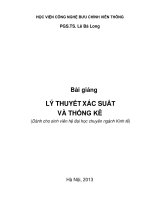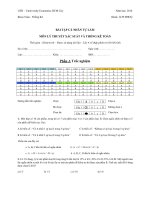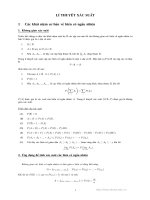Tài liệu Slide bài giảng môn Lý thuyết xác suất thống kê bằng Tiếng Anh StatisticsLecture4C_HypothesisTest
Bạn đang xem bản rút gọn của tài liệu. Xem và tải ngay bản đầy đủ của tài liệu tại đây (102.62 KB, 11 trang )
Test for two related (paired) samples
•
Compare two mean values
•
Non-parametric test
Compare mean values of two related samples
For related variables X and Y , the comparison of
mean values is equivalent to the comparison the mean
value of the difference variable X Y– to value 0
the problem reduces to one-sample model. When
sample size is large or when the difference of the two
variable has Normal distribution, Student test (T test)
can be appropriate.
SPSS
Non-parametric method for two paired samples -
Wilcoxon signed rank test
T-tests are appropriate only for the cases when
variables are Normal distributed or when sample
sizes are large. For small sample size studies of
non-Normal distributions, non-parametric
methods must be used. Wilcoxon signed rank
test: non-parametric method for two related
(paired) samples.
Given two related samples
H : X and Y have common distribution
(two variables X and Y are identically distributed)
in constrain to Alternative Hypothesis
K: distributions of X and Y are different
(most of X s’ values can appear in positions higher than
those of Y s’ values or inversely, most of Y’s values
have positions higher than those of X’s values)
Wilcoxon signed rank test checks Hypothesis
1 2
1 2
( , , , )
( , , , )
n
n
X X X
Y Y Y
SPSS
Procedure:
Calculate differences - and the ranks (| |)
omitting ties
Step 1.
0 , 1,2, ,
i i i i
i
d X Y h d
d i n
=
= =
2
Calculate quantiies
(| |) , (| |) and min( , )
where { : 0} , { : 0}
S
;
.( 1)
#( ) #( ) , ;
4
.( 1).(2
tep 2.
m i m
m K m K
j j
T
T h d T h d T T T
K j d K j d
n n
n K K T
n n
S
− +
− + − +
∈ ∈
− +
+ +
+ − +
+ +
= = =
= < = >
+
= + =
+
=
∑ ∑
2
1)
, =
24
T T
n
S S
+
+
1 2 1 2
LEMMA. Let ( , , , ) and ( , , , ) be
paired samples from two continuous varables and .
Suppose that hypothesis H is true. Then the distribution
of variable tends very fast to Normal
n n
X X X Y Y Y
X Y
T
2
*
distribution ( , )
and then distribution of variable
t
approximates the standard Normal distribution (0,1) .
T
T
N T S
T T
S
N
−
=
With the above lemma, for n >7 the testing can be
continued as follows:
Step 3. (by computer) Taking standard Normal distribution
N(0,1) to calculate the probability
b = P { |N(0,1) | > | t* |}
Step 4. Compare b significant level alpha
* If b > alpha accept Hypothesis H , cuclude X
and Y to have common distribution
* If b <= alpha reject Hypothesis H , confirm that
X and Y have different distributions
Step3 B. Using critical value
For significant value alpha=5% take critical
value (for standard Normal distribution) equal
1.96 and
*
| 9| 6 1.t ≥
Decide
- Reject Hypothesis H if
- Accept Hypothesis H if
*
| 9| 6 1.t <
SPSS









